
Directed by Nicholas Meyer, The Day After disturbed a generation of TV audiences in 1983. On the 40th anniversary of its first airing, we look back at its immediate and lasting impact.
“If you can, take a quick look out of the window,” said TV host Ted Koppel immediately after the first airing of The Day After on the 20th November, 1983. “It’s all still there. Your neighbourhood is still there. So is Kansas City. And Lawrence. And Chicago, San Diego, Moscow and Vladivostok…”
Koppel’s words of reassurance were a sign of how nervous the ABC Network was about airing its multi-million dollar, two-hour feature about the nuclear destruction of the United States. The company had reason to be on edge: aside from the expense, the film had alienated advertisers, angered the political right, and left ABC executives fearing that audiences would switch off their televisions – all before the film had even aired.
The Day After was, however, a ratings success that US television would seldom match again – some 100 million people watched the film that November, making it one of the most watched TV shows of all time.
From our perspective 30 years later, it might be difficult to appreciate what an anomaly The Day After was. At a time when Hollywood directors looked down on TV as a lower form of entertainment, The Day After managed to attract Nicholas Meyer – then fresh off the success of Star Trek II: The Wrath of Khan (1982). The Day After’s production values and budget – a reported $7 million – were high for the early 1980s, and its tone and subject matter ran entirely counter to ABC’s other TV movies of the era (examples include But I Don’t Want to Get Married! and The House That Would Not Die).
The Day After dealt head-on with one of the most ominous potential outcomes of the Cold War: a collapse in relations between the west and the Soviet Union, and the deaths of millions of people in the wake of nuclear war. In some respects, The Day After is a disaster film much like the cycle of Irwin Allen-produced flicks that attracted cinemagoers from the late 1960s onwards. But where those films were star-led, sensationalistic and generally contained at least a shred of triumph, The Day After is unrelentingly downbeat. It follows assorted doctors, teachers, teenage lovers, families and low-ranking soldiers as they go about their daily lives, which are then dashed to pieces when the missiles fall. Those characters battle on in the aftermath, each in their own way, only to succumb to radiation sickness, exhaustion, or psychological collapse.
Ambitious for their time, The Day After’s visual effects – a mixture of optical effects and stock footage – have dated markedly, as have some of the makeup effects and moments of hammy acting. All the same, the film has a kind of compounding effect – a bleakness that builds and seeps into the bones. Meyer’s talents as a director can be seen most clearly in the wider shots – people swarming through streets in blind panic; a striking, Gone With The Wind-inspired sequence of the dead and dying packed into a vast sports hall. For 1980s television, it was strong stuff.
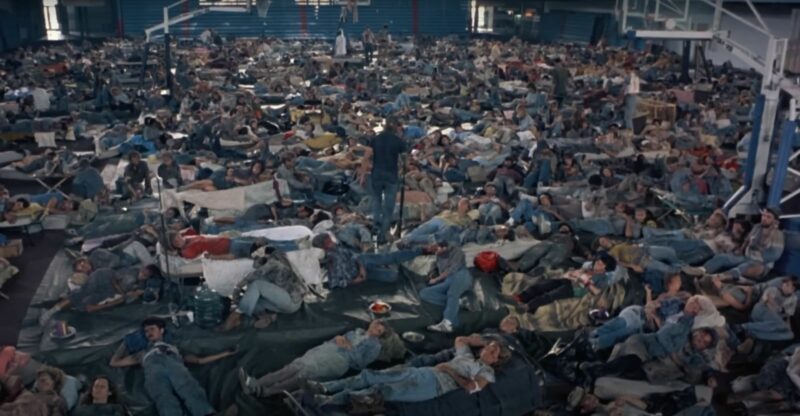
The day before
The Day After began as a concept dreamed up by Brandon Stoddard, the president of ABC’s Motion Picture Division, who was looking around for a TV project that carried similar thematic heft as the acclaimed series mini-series Roots – adapted from a best-selling book about slavery in America – delivered in 1977. Inspired by The China Syndrome, a film about a leak at a nuclear power plant, Stoddard resolved to make something even more stark and topical.
Stoddard’s idea met resistance from other executives at the studio almost immediately, and the sense of nervousness would linger throughout production. Speaking on Atomic Hobo, a podcast dedicated to the subject of nuclear war, Nicholas Meyer recalled sitting with the members of ABC’s Standards and Practices department – whom Meyer described as the network’s ‘censors’- and arguing at great length what could and could not be shown on television. While several movies about the prospect of nuclear war had been made by 1983 – among them Stanley Kubrick’s masterpiece, Doctor Strangelove – none had been made for primetime television. None had been put in front of families with young children.
As a result, the department picked nervously through Edward Hume’s script, originally entitled A Silence in Heaven. Did there have to be such graphic scenes of death and blood, they wondered? Did audiences really need to see all these incinerated bodies? Even comparatively small moments, like the mention of a contraceptive in one brief scene, raised hackles. “The diaphragm is out,” one of them said. “We will not knowingly appear to endorse birth control.”
The network also had the political angle to consider. With the Cold War again escalating, nuclear disarmament was a topic high on the public agenda; in June 1982, a year before The Day Before aired, hundreds of thousands of people lined the streets of New York City to protest the United States’ decision to increase the production of nuclear weapons, as signed off by then-president Ronald Reagan. Keen to avoid offending right-leaning viewers, or risk accusations of being pro-disarmament, ABC insisted that politics be left out of the film altogether. One executive argued that it should be made plain that the Russians fired their salvo of missiles first.
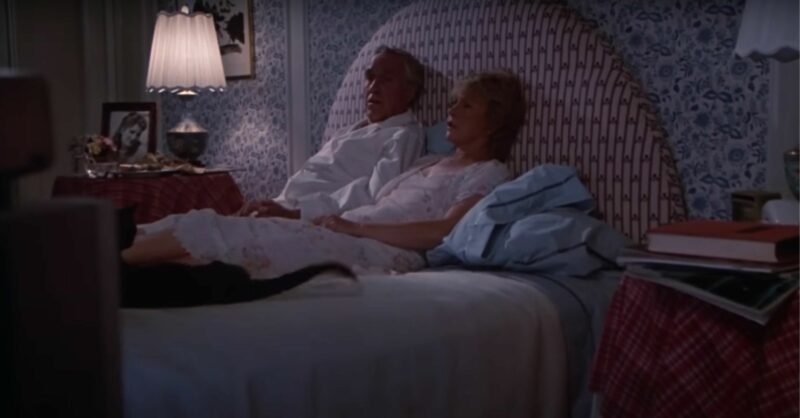
If ABC wanted to avoid politics, Meyer and screenwriter Edward Hume had other ideas. Unbeknown to the network, Hume was a firm supporter of the disarmament movement, and envisioned his screenplay as an anti-nuclear polemic. Meyer went a step further: he stated, in the excellent 2020 documentary Television Event, that he wanted the film to “unseat Ronald Reagan.”
“Ronald Reagan came to power and I was appalled, because I thought he was a jerk,” Meyer said. “What Reagan brought to the table was the notion of a winnable nuclear war – it was survivable. He thought a lot of nutty things. I was thinking, if I just made a film showing what nuclear war was, I could unseat Ronald Reagan when he ran for re-election.”
Meyer, evidently a headstrong sort, continued to clash with ABC executives as filming began in Kentucky. At one stage, one higher-up called Meyer, furious that he’d shot a scene the network had said couldn’t be used in the final film. “Fire me,” Meyer responded, confident that he had enough allies with him on the movie that they’d all quit if he was forced off the production.
Meyer ultimately got his way, but did eventually tone down some of the grislier details he’d originally shot. Behind the scenes footage, for example, shows Meyer and his crew filming a scene in which a young family attempts to escape disaster in a flatbed truck, only to be struck by a nuclear blast. The crew originally doused several life-sized dummies – including one of a little boy – with what appeared to be a flamethrower, and the effect is enormously unsettling. In the finished film, the same sequence is obscured by a less grotesque curtain of fire, optically composited on top of the original footage.
(These repeated scenes of the dead and dying took their toll on both cast and crew; actor Steve Guttenberg, who plays a college student, said he regularly had nightmares about nuclear missiles striking – ‘nukemares’ he coined them, according to Meyer.)
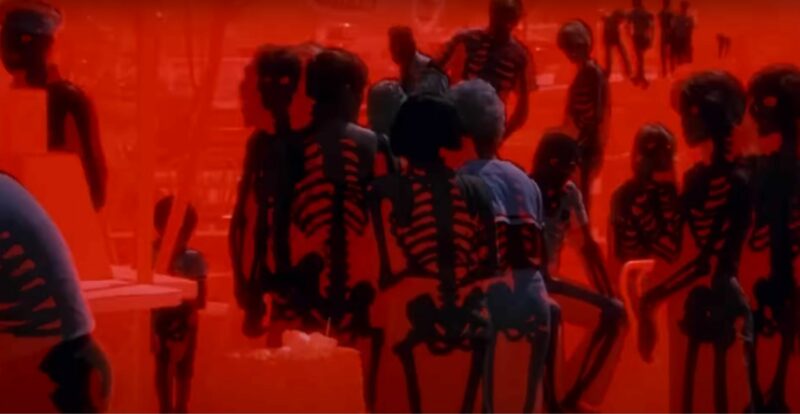
Mushroom clouds
Exactly how to make the image of nuclear missiles striking American soil was one of The Day After’s most complex puzzles. How do you create a convincing-looking mushroom cloud on a TV budget? One producer who played a pivotal role in solving the problem was Stephanie Austin, who coordinated the film’s visual effects. Eventually, Austin and her effects team came up with an ingenious solution: a dollop of cream was filmed as it fell from a spoon into a tank of water. The image was flipped upside down, and the result looked remarkably like the aftermath of a nuclear explosion.
Towards the end of the 1980s, Stephanie Austin moved to the production company Carolco, where James Cameron was working on what was initially conceived as a low-budget sequel to 1984’s The Terminator. Cameron was so impressed by Austin’s work on The Day After, he hired Austin as a co-producer on what would become Terminator 2: Judgment Day. “I went into his office and read the first few pages of Terminator 2 and decided I should go home,” Austin told me in 2017. “Because there was no way I could produce this for the amount of money he wanted to make it for.”
Terminator 2: Judgment Day was eventually made for around $100 million – then a record-breaking sum. Like The Day After, it too contained some singularly disturbing scenes of nuclear devastation.

In the cut
Originally commissioned, written and shot as a four-hour epic to be aired in two parts over consecutive nights, The Day After was gradually whittled down to just two hours over the course of its edit. It was a decision led by commerce rather than artistry; as advertisers got wind of what ABC had in production, they recoiled. By the time the film’s airdate neared, barely any advertisers were left – meaning there was no commercial reason to string the narrative out over two nights of prime time, since there were barely any ads to screen during either instalment.
Eventually, the reaction among advertisers became so toxic that ABC was forced to sell ad slots at just $11,000 each. Even then, there were barely any takers – Meyer later reckoned that only computer manufacturer Commodore and popcorn merchant Orville Redenbacher’s bothered to book a slot.
In the meantime, ABC continued to lean on Meyer in the hope of getting him to tone down the film’s withering imagery. Matters eventually became so bad that Meyer’s editor was fired, Meyer himself was either removed or walked away from the production, and for a few weeks, the film was cut together without him (“I crawled into bed,” the director later recalled. “I don’t know how seriously I was thinking about suicide, but I was extremely depressed.”)
Weeks later, Meyer returned to oversee the final 126 minute cut that would eventually air.
“Nobody at ABC wanted this movie,” Meyer told the Atomic Hobo podcast. “Everybody hated it. Everybody knew that the sponsors would hate it – and indeed, they hated it so much that no one sponsored the movie.”
Things got even more heated when the White House saw the movie, feared it would sway public opinion against Reagan, and began to demand edits. “We had a legal department say, ‘I think we’ve got to pull this,’” Stoddard recalled in Television Event. “I was totally isolated. The sales department didn’t want it to go on the air. The legal department didn’t want it to go on the air. Management didn’t talk to me. Staff didn’t talk to me… the White House issued a statement to ABC: ‘We want the following edits.’ And I said, ‘Tell them to fuck off. We’re not touching the film.’”
“In order to get this on the air, he [Stoddard] had to threaten to resign if they didn’t go through with it,” said Meyer.
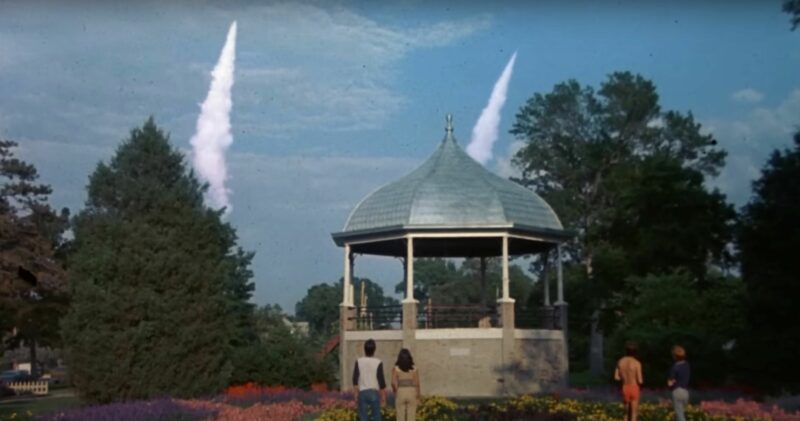
The moment of truth
ABC’s executives eventually relented and allowed The Day After to be televised – but not without a lengthy disclaimer at the start warning of its disturbing scenes, and a pre-recorded introduction by actor John Cullum, who sternly advised parents not to let young children watch.
Then there was that special edition of news programme Viewpoint, essentially a post-film debriefing show, scheduled to run immediately after its conclusion. The White House, having initially reacted defensively to the film, sought to have someone from the government appear on Viewpoint to provide a reassuring tone. Initially, Ronald Reagan himself was considered; ultimately, secretary of state George Schultz appeared, along with a panel that also included former secretary of state Henry Kissinger and astronomer Carl Sagan.
Again, the idea was for the post-film show and its debate to “chill everybody out,” to quote Meyer. Sagan, however, had more doom and gloom to share. Some 10 minutes into the show, he calmly pointed out something unknown to the makers of The Day After: that if hundreds of nuclear warheads were detonated at the same time, the resulting cloud would block out the sun for at least a year, sparking a ‘nuclear winter’ that would kill almost all animal and plant life. In other words, The death and destruction depicted in The Day After was far less horrifying than the potential reality.
Still, Meyer argued that his film’s relative cosiness had its benefits. Had the film been too horrifying, he argued, then viewers would have switched off. “I knew that I was really making the optimist’s version of a nuclear war,” Meyer said, “because if I made it like it was really going to be like – like the British movie Threads [released in 1984] – then they’d reach for the clicker and just not watch it.”
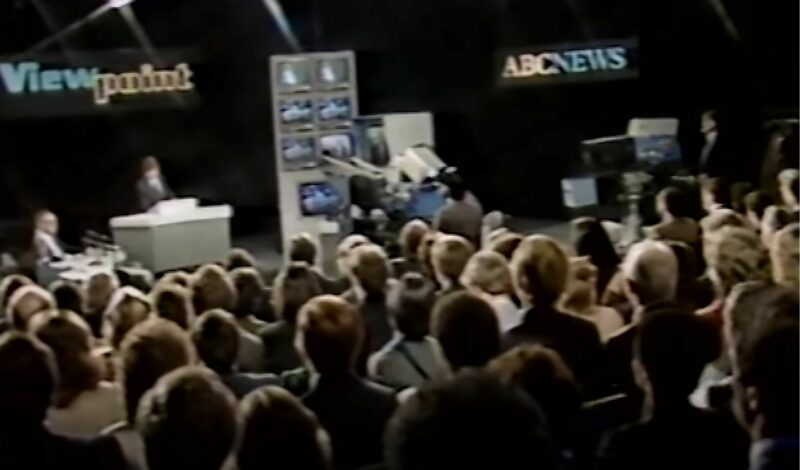
Read more: Threads | Revisiting one of the most terrifying films ever made
Ronald Reagan certainly watched The Day After, and was evidently disturbed by what he saw; he later wrote in his diary that the film left him “greatly depressed”. In the aftermath, Reagan’s hawkish, victory-at-all-costs attitude to the Cold War softened. “In order to protect our civilisation in the modern age,” he later said before Congress, “a nuclear war cannot be won and must never be fought.”
Less than a month after it aired in the US, The Day After was screened on UK television on 10 December 1983. Again, the film was followed by a debate program, After The Day After, this one presented by the glowering host Robert Kee, who reassured audiences with some remarkably familiar words: “Is there anybody there? Yes, we’re all still here, in Kansas, in London, in Leeds and in all the other city regions of the world…”
All told, some 15 million British people watched The Day After according to a report in The Washington Post – putting it on a par with Esther Rantzen’s popular program, That’s Life.
How directly The Day After affected the course of the Cold War is debatable; that it was one of the most controversial and talked-about pieces of entertainment of 1983 is undeniable. Meyer’s film arrived as tensions between east and west were at their height – indeed, former former US Air Force Intelligence officer Brian J Mora wrote in 2022 that the world came closer to nuclear destruction than anyone at the time knew.
“As grave as the stakes were in 1963, they were far greater in 1983,” Mora wrote in an article on the website Air and Space Forces. “By then, the size and capabilities of US and Soviet forces dwarfed those in 1962. Had both sides’ nuclear arsenals been fully employed in 1983, nuclear armageddon would have been inevitable.”
Mora describes several near-misses that occurred that year, including a potential dogfight between US and Soviet aircraft which was only avoided when a US commander ordered his pilots not to engage. “I don’t think I’ll start World War III this afternoon,” the commander had said.
Watch The Day After in 2023, and it still has a searing impact, in spite of the elements that have long since dated. Perhaps that’s because, following Russia’s invasion of Ukraine, those old Cold War anxieties are beginning to resurface. Or maybe it’s because, even though the fear of nuclear war isn’t lodged in our collective brains quite as it was in the late 20th century, its threat still remains. Those neighbourhoods may still be outside our windows, but the nuclear missiles also still sit in their silos.
A version of this article originally appeared in issue 46 of Film Stories magazine. Copies are available to order now.





